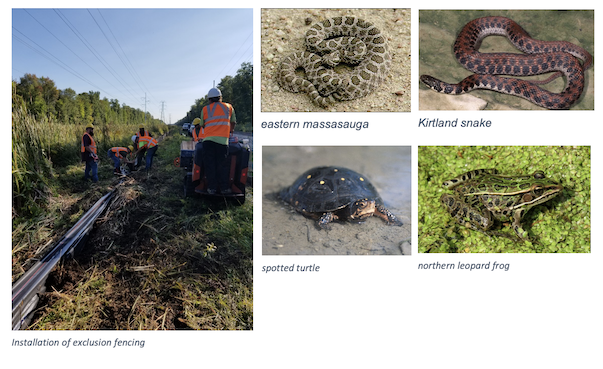Environmental Mitigation
NICTD has committed to specific mitigation measures that are intended to reduce the adverse effects of the DT-NWI Project. The information below summarizes the mitigation measures that the FTA and NICTD committed to in the 2017 Environmental Assessment (EA) and 2018 Finding of No Significant Impact (FONSI) under the National Environmental Policy Act (NEPA). NICTD’s implementation of these mitigation commitments is part of the approval and issuance of the FONSI. There were some changes to the Project during final design but it was determined that the modifications would not result in significant impacts, appropriate measures were incorporated to mitigate impacts where needed, and the findings of the 11/1/2018 FONSI were still valid. FTA concurred with the modifications and impact determination on September 22, 2020.
The progress and current status of each environmental commitment is provided in the file below. This information will be updated on the Double Track NWI project website on a quarterly basis, at a minimum. Should you have questions about items on this list, please call 219-850-4457 or email [email protected].
Environmental Mitigation Status as of January 13, 2021
Environmental Mitigation Status as of August 25, 2021
Environmental Mitigation Status as of December 21, 2021
Environmental Mitigation Status as of April 1, 2022
Environmental Mitigation Status as of July 25, 2022
Environmental Mitigation Status as of October 31, 2022
Environmental Mitigation Status as of January, 26, 2023
Environmental Mitigation Status as of May 2, 2023

Mitigation Highlight
Environmental Mitigation Status Reports, also known as Green Sheets, are updated and posted on a quarterly basis to provide information about the Environmental Commitments NICTD made for the Double Track NWI Project and how those commitments are being fulfilled. The Environmental Commitments include mitigation measures that were designed or selected to reduce potential adverse effects of the project, as well as enhance the local community and acknowledge the historic and social context of the project area. Project specific mitigation measures relate to construction noise and vibration, air quality, visual and aesthetics, land acquisition, cultural and historic resources, trails, national and biological resources, wetlands and water quality, hazardous and contaminated materials, and transportation. Click here for the latest update.
Stormwater Runoff
Impermeable surfaces, which include materials such as concrete, asphalt, and traditional pavers, do not allow stormwater to penetrate into the ground. This forces the water to run off the impermeable surface, which can lead to flooding, erosion, and pollution of surface water – especially during significant rain events. To avoid and mitigate issues from stormwater runoff, NICTD is using permeable interlocking concrete pavers (PICP) at strategic locations at the Miller Station, the Portage/Ogden Dunes Station, and the Dune Park Station. This decision was made in the best interest of the important natural environments surrounding these stations, most notably the Indiana Dunes National Park. These interlocking cellular concrete blocks have an arched storage chamber for additional water capacity on the underside of the block. Once stormwater drains through the tiny spaces between the blocks, it is temporarily held in the arched storage chamber before naturally seeping into the ground.
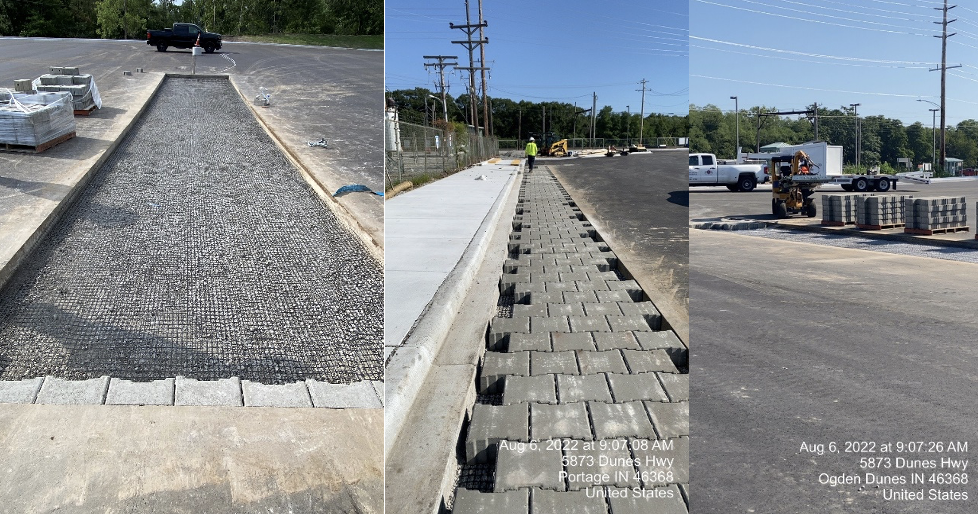
Welland Ditch
Linear infrastructure often presents a barrier to movement for wildlife. During the Double Track project planning stage, a great deal of consideration was given to protecting natural resources during and after construction. One example is the installation of wildlife shelves within the larger culverts, such as this one at Weiland Ditch. Thanks to coordination with the Indiana Department of Natural Resources, National Park Service, US Fish and Wildlife Service and others, these shelves are now being installed as the last work is nearing completion on the larger culverts.
Studies have shown that wildlife actively use these shelves. Empirical evidence suggests multiple species of small and medium wildlife use these shelves during periods where high water levels would otherwise make it difficult or not possible to cross. Providing a mechanism for safe crossing helps to reduce habitat fragmentation. Wildlife shelves are relatively easy to retrofit in existing culverts or include in a newly constructed culvert and are a relatively simple and cost-effective method of wildlife protection and conservation.
The Indiana Dunes National Park is working on a regional basis to determine other opportunities for wildlife crossings. NICTD is proud to be a part of such partnerships.
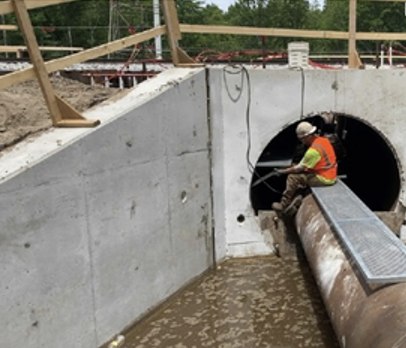
First Christian Church (Bride Church)
The First Christian Church, also known as the Bride Church, was built in 1907 and listed in the National Register of Historic Places (NRHP) within the Elston Grove Historic District. The church building has sat empty since 2016, when a lightning strike started a fire that caused severe damage to the building. The church relocated to another facility in downtown Michigan City.
NICTD purchased the parcel in 2021. Because of its historic significance of the building, the First Christian Church required coordination with the National Park Service (NPS) to document the engineering and architecture history of its development. NICTD prepared a Historic American Building Survey (HABS) document for approval by the NPS. In December 2020, the HABS report was provided to the Indiana State Historic Preservation Officer (SHPO), the Indiana Room at the Michigan City Public Library, and the Calumet Regional Archives at the Indiana University Northwest Library. The NPS and SHPO approved the final HABS report under a memorandum of agreement in January 2021.
Prior to demolition of the building, religious and sensitive items within its structure were salvaged. Specifically, the cross that hung in the church’s apse was salvaged and donated to a local Catholic charity, where it was preserved and repurposed in a private chapel in Greensburg, Indiana.
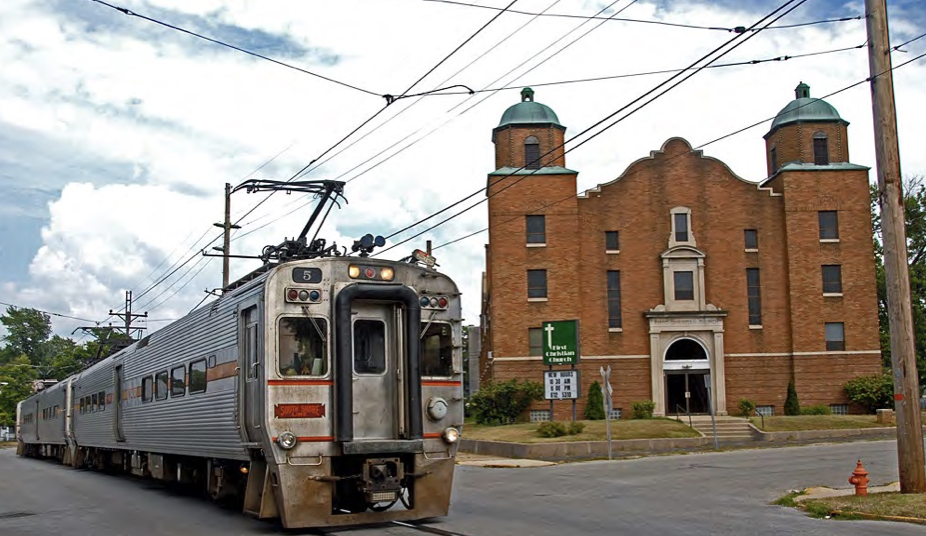
South Shore Line train and First Christian Church, Michigan City, Indiana.
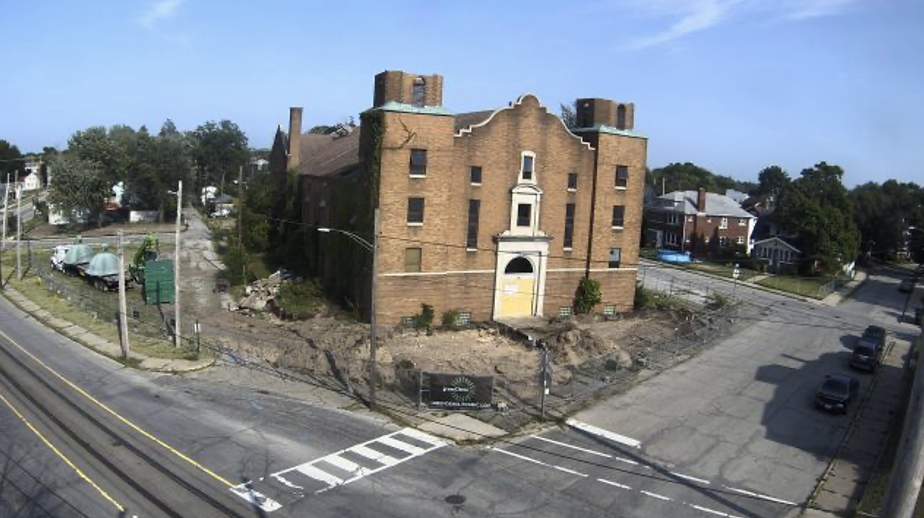
Demolition activities of First Christian Church.
NICTD Tree Planting
In early May 2021, NICTD planted 30 trees of three different species: American Beech (Fagus grandifolia), Shingle Oak (Quercus imbricaria), and Kentucky Coffeetree (Gymnocladus dioicus) in the National Park Service’s Heron Rookery in Porter County. All three tree species are native to the Midwest region, and Beech trees even yield beechnuts that birds and small mammals, such as squirrels and chipmunks, rely on as food sources. The planting of these trees aids in the reintroduction of native species to our landscapes, thereby increasing biodiversity and benefits to wildlife.
The tree planting was a key element in the mitigation plan developed in coordination with local expert botanists, National Parks Service, and Indiana Department of Natural Resources. Construction of the Double Track Northwest Indiana Project would require clearing of woodland along the project area. The mitigation plan was developed to help offset the loss of natural resources through the protection and restoration of a different landscape. Monitoring of the tree plantings is included in the mitigation plan and will continue through May 2024.



Threatened & Endangered (T&E) Species Avoidance Plan
NICTD prepared a Threatened & Endangered (T&E) Species Avoidance Plan in cooperation with the U.S. Fish and Wildlife Service as part of the Section 7 Endangered Species Act consultation for the DT-NWI Project. As part of the plan, NICTD agreed to provide protections to T&E species prior to construction. One protection included the installation of a temporary exclusion fence, similar to a silt fence, around areas of suitable habitat for the following T&E reptile and amphibian species:
• eastern massasauga (Sistrurus catenatus; Federally Threatened, State Endangered)
• Kirtland snake (Clonophis kirtlandii; State Endangered)
• spotted turtle (Clemmys guttata; State Endangered
• northern leopard frog (Lithobates pipiens; formerly Species of Conservation Concern)
The U.S. Army Corps of Engineer’s Clean Water Act Section 404 permit requires that no digging, excavating, or filling can occur in areas with high-quality wetlands between October 16 and April 14. To prepare for construction in early 2022 and avoid work during seasonal window restrictions, NICTD installed exclusion fencing in certain areas adjacent to and within the Indiana Dunes National Park in August and September 2021.
The fence will help to keep protected species out of construction work areas. A qualified herpetologist and biologist were on site during the installation of fencing to monitor for the presence of species. NICTD’s contractor working in the construction areas have herpetologists on their team for ongoing monitoring during construction. Biologists on NICTD’s Construction Management Team also complete weekly biological observations. No protected species have been observed in the work areas to date.
